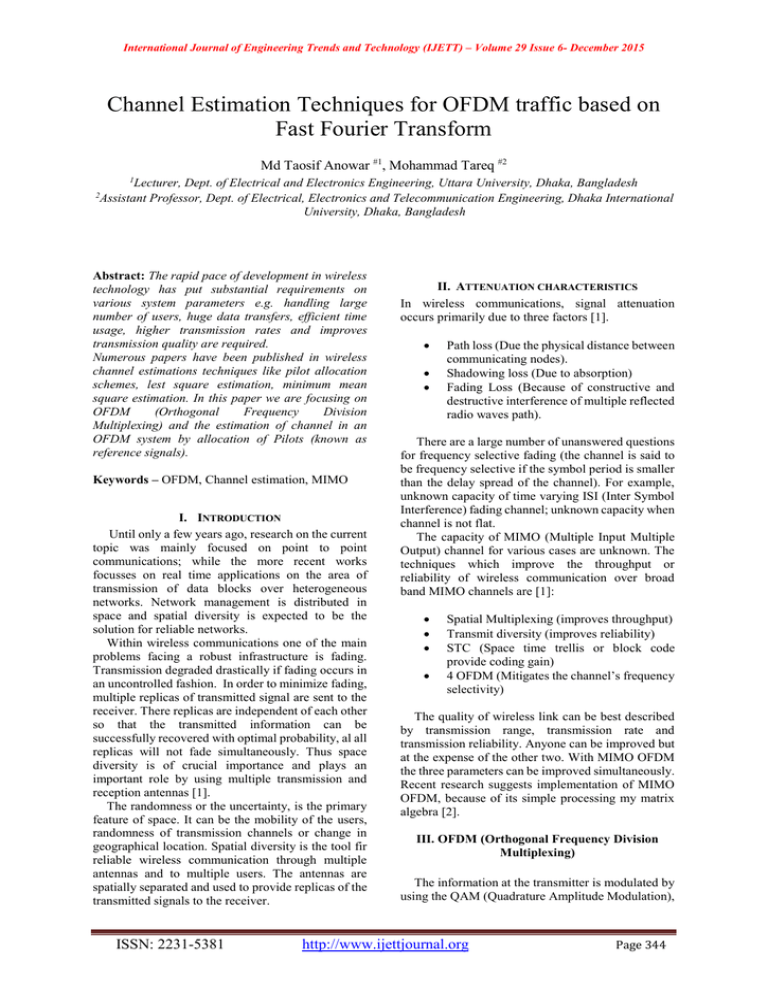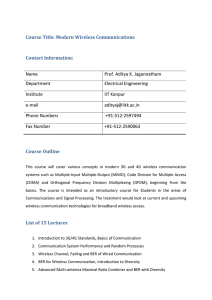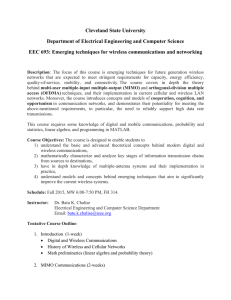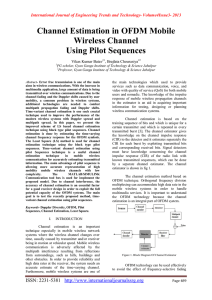Document 12914485
advertisement

International Journal of Engineering Trends and Technology (IJETT) – Volume 29 Issue 6- December 2015
Channel Estimation Techniques for OFDM traffic based on
Fast Fourier Transform
Md Taosif Anowar #1, Mohammad Tareq #2
1
Lecturer, Dept. of Electrical and Electronics Engineering, Uttara University, Dhaka, Bangladesh
Assistant Professor, Dept. of Electrical, Electronics and Telecommunication Engineering, Dhaka International
University, Dhaka, Bangladesh
2
Abstract: The rapid pace of development in wireless
technology has put substantial requirements on
various system parameters e.g. handling large
number of users, huge data transfers, efficient time
usage, higher transmission rates and improves
transmission quality are required.
Numerous papers have been published in wireless
channel estimations techniques like pilot allocation
schemes, lest square estimation, minimum mean
square estimation. In this paper we are focusing on
OFDM
(Orthogonal
Frequency
Division
Multiplexing) and the estimation of channel in an
OFDM system by allocation of Pilots (known as
reference signals).
Keywords – OFDM, Channel estimation, MIMO
I. INTRODUCTION
Until only a few years ago, research on the current
topic was mainly focused on point to point
communications; while the more recent works
focusses on real time applications on the area of
transmission of data blocks over heterogeneous
networks. Network management is distributed in
space and spatial diversity is expected to be the
solution for reliable networks.
Within wireless communications one of the main
problems facing a robust infrastructure is fading.
Transmission degraded drastically if fading occurs in
an uncontrolled fashion. In order to minimize fading,
multiple replicas of transmitted signal are sent to the
receiver. There replicas are independent of each other
so that the transmitted information can be
successfully recovered with optimal probability, al all
replicas will not fade simultaneously. Thus space
diversity is of crucial importance and plays an
important role by using multiple transmission and
reception antennas [1].
The randomness or the uncertainty, is the primary
feature of space. It can be the mobility of the users,
randomness of transmission channels or change in
geographical location. Spatial diversity is the tool fir
reliable wireless communication through multiple
antennas and to multiple users. The antennas are
spatially separated and used to provide replicas of the
transmitted signals to the receiver.
ISSN: 2231-5381
II. ATTENUATION CHARACTERISTICS
In wireless communications, signal attenuation
occurs primarily due to three factors [1].
Path loss (Due the physical distance between
communicating nodes).
Shadowing loss (Due to absorption)
Fading Loss (Because of constructive and
destructive interference of multiple reflected
radio waves path).
There are a large number of unanswered questions
for frequency selective fading (the channel is said to
be frequency selective if the symbol period is smaller
than the delay spread of the channel). For example,
unknown capacity of time varying ISI (Inter Symbol
Interference) fading channel; unknown capacity when
channel is not flat.
The capacity of MIMO (Multiple Input Multiple
Output) channel for various cases are unknown. The
techniques which improve the throughput or
reliability of wireless communication over broad
band MIMO channels are [1]:
Spatial Multiplexing (improves throughput)
Transmit diversity (improves reliability)
STC (Space time trellis or block code
provide coding gain)
4 OFDM (Mitigates the channel’s frequency
selectivity)
The quality of wireless link can be best described
by transmission range, transmission rate and
transmission reliability. Anyone can be improved but
at the expense of the other two. With MIMO OFDM
the three parameters can be improved simultaneously.
Recent research suggests implementation of MIMO
OFDM, because of its simple processing my matrix
algebra [2].
III. OFDM (Orthogonal Frequency Division
Multiplexing)
The information at the transmitter is modulated by
using the QAM (Quadrature Amplitude Modulation),
http://www.ijettjournal.org
Page 344
International Journal of Engineering Trends and Technology (IJETT) – Volume 29 Issue 6- December 2015
as illustrated in Figure 1. In OFM large number of
carriers are required, it means large number of local
oscillators are required which makes the system more
complex. Here the digital signal processing
techniques like IFFT (Inverse Flat Fourier Transform)
and FFT (Fast Fourier Transform) comes and handles
the situation quite easily. The modulated signal is
then converted to parallel for applying IFFT (inverse
Flat Fourier Transform) so that the signals are placed
at orthogonal distances, as illustrated in Figure 2.
IFFT is an efficient algorithm which generated
OFDM symbols by performing both processes
(Modulation and Multiplexing). The transmitted
signal can be represented as
𝑥 (𝑡) = ∑𝑁−1
𝑛=0 𝑎𝑛 𝑝𝑛 (𝑡)
Where an is the QAM symbol and
rectangular pulse shifted in frequency,
𝑗2𝜋𝑛𝑡
𝑇
𝑃ℎ = {1⁄𝑇𝑒
0
(1)
pn (t) is the
1
𝑇
𝑁
0<𝑡<𝑇
𝑜𝑡ℎ𝑒𝑟𝑤𝑖𝑠𝑒
(2)
t is
𝑘
𝑗2𝜋𝑛
𝑛
𝑋(𝑘) = ∑𝑁−1
𝑛=0 𝐴𝑛 𝑒
𝑇
Fig. 2 OFDM signals spaced on frequency domain
IV. Cyclic Prefix (CP)
Where T is the pulse duration.
The discrete time representation of the pulses if
they are sampled at tk =K
As illustrated in Figure [2], the IFFT places the
infinitely long sinusoids close to each other such that
they are not interfering, as they are orthogonal to each
other. This is how the high bandwidth efficiency is
achieved.
(3)
The insertion of cyclic prefix is to deal with the
problem of time dispersion. When the received signal
is undistorted, the demodulation performed gives the
original signal. But if the channel is dispersive (Inter
symbol/carrier Interference with in the sub carrier
between the subcarriers) as illustrated in Figure 3, the
OFDM signal lost its orthogonality.
To make OFDM signals independent of
dispersive effects, cyclic prefix is used [3]. The CP is
added at the beginning of the OFDM symbol whose
length is equal or greater than the channel dispersion.
Obviously it increases the length of the OFDM
Fig.1 OFDM Block diagram [8]
Fig.3 Inter Carrier Interference [7]
The output of the IFFT consists of N values. The
output thus converted from parallel to serial (as
illustrated in Figure 1) then cyclic prefixes are added
to make signals ready for transmission.
symbol, but it serves as a guard interval, as illustrated
in Figure 3. When the data is transmitted over a delay
dispersive channel, the received signal is the linear
convolution of the transmitted signal and the channel
impulsive response. This linear convolution is then
ISSN: 2231-5381
http://www.ijettjournal.org
Page 345
International Journal of Engineering Trends and Technology (IJETT) – Volume 29 Issue 6- December 2015
converted to cyclical convolution because of cyclic
prefix. According to the DFT theory, multiplication
of two DFTs is circular convolution in time domain.
V. CHANNEL ESTIMATION
A particular wireless channel cannot be perfectly
known therefore we estimate the channel. It basically
beans we have to find the channel transfer function or
its impulse response. There are many techniques for
estimating the channels like pilot based estimation.
Adaptive estimation and frequency time correlation
based estimation [4]
A. Pilots Allocation schemes
Fig. 4b Comb Type Pilot Channel Estimation [6].
To find the behavior of wireless channel, pilots are
placed in the data, thus it is required to use less pilots
as much as possible. There are various methods for
placing in time frequency domain of OFDM systems.
B. Block and Comb Type Pilots allocation.
In block type, the pilots are placed on each
subcarrier frequency having some time period (as
illustrated in figure 4a) and in comb type, the pilots
are placed on sub carriers apart from each other (as
illustrated in figure 4b). The former is useful in high
frequency dispersive and low Doppler frequency
channel at the cost of data rate [5]. The latter type is
useful in moderate frequency selective and high
Doppler frequency channels [5]. They are called
block type pilot placement method
In block type, at every sub carrier frequency the
channel is known, while in comb type the condition
of the channel is not known at every sub carrier
frequency so at the intermediate sub carrier
frequencies the channel can be estimation by
interpolation.
The same channel estimation is used the whole block
in block type channel estimation; while in comb type,
some reserved sub carriers are used for each block.
The time and frequency spacing between the
subcarriers should be acceptable for estimating the
channel perfectly.
Initially the pilots (known signals) are transmitted
over the channel and since the output known, one can
easily find the channel characteristics by its transfer
function. If X(t) is the known pilot signal, expected
output is y(t) then h(t) is the impulse response of the
channel, therefore the transfer function can be found.
Once the channel transfer function is known, the
channel can be estimated.
VI Conclusion
The paper describes the orthogonal frequency
division multiplexing technique. It shows how the
OFDM technique optimizes bandwidth efficiency and
the use of cyclic prefix makes the signal independent
of dispersive effects. The Block and Comb type
channel estimations by using pilot’s allocation
schemes are discussed and shown how the channel
transfer function can be found by transmitting the
known signals (pilots). Block type pilot allocation is
advantageous in high frequency selective and low
Doppler Frequency channels. While the comb type is
advantageous in moderate frequency selective and
high Doppler frequency channels.
REFERENCES
[1] Constantine A. Blanis, Antenna Theory analysis and Design.
[2]
Fig. 4a Block Type Pilot Channel Estimation [6].
The receiver decodes the received symbol by
estimated channel condition until the next pilot
symbol arrives [6].
ISSN: 2231-5381
[3]
[4]
Wiley, ISBN 987-0-471-66782-7, 3rd edition, May 2005
MingJiang, Lajos Hanzo, Multiuser MIMO-OFDM for next
generation wireless systems, Proceedings of IEEE vol 95, No.
7, July 2007
Andreas F. Molisch, Wireless Communication, Wiley, West
Sussex 2005.
Sinem Coleri, et al.,Channel Estimation Techniques Based on
Pilot Arrangement in OFDM systems, IEEE Transactions in
Broadcasting, Vol 48, No.3, September 2002.
http://www.ijettjournal.org
Page 346
International Journal of Engineering Trends and Technology (IJETT) – Volume 29 Issue 6- December 2015
[5] Meng-Han Hsieh, Che-Ho Wei, Channel Estimation for
[6]
[7]
OFDM Systems Based on Comb Type Arrangement in
Frequency Selective Fading Channels, IEEE Transactions on
Consumer Electonics, Vol44, No.1, February 1998.
Yushi Shen, Ed Martinz, Channel Estimations in OFDM
Systems, Free Scale Semiconductor, Inc. 2006.
http://www.ieeevic.org/events/docs/72_armstrong_ofdm.pdf,
date May 13th 2011
Authors
Md. Taosif Anowar: Md Taosif
Anowar obtained his Master of
Science in Electrical Engineering from
Linkoping University, Sweden; with a
specialization on Wireless Networks.
He completed his bachelors on
Electrical and Electronics Engineering form AIUB
Dhaka. Currently he is serving as faculty member at
Uttara University, Dhaka; in the department in
Electrical and Electronics Engineering. His current
areas of interest include QoS optimization in
LTE/LTE-A networks, 5G Standardization, and Inter
- Vehicular Comm. Networks
Mohammad Tareq: Mohammad
Tareq working as an Assistant
Professor of dept. of Electrical,
Electronics
and
Telecommunication Engineering of
Dhaka International University,
Bangladesh.
He
obtained
M.Sc.Engg. in Electrical and Electronic Engineering
(EEE) and B.Sc. in Electrical and Electronic
Engineering (EEE) from American International
University-Bangladesh (AIUB). He also obtained
M.S. in Telecommunication Engineering from EastWest University, Bangladesh. His interests of
research are – microstrip patch antenna, fiber-optic
communications and wireless communications.
ISSN: 2231-5381
http://www.ijettjournal.org
Page 347




